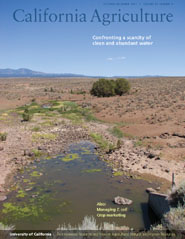


University of California
California Agriculture



|
|||
|
|||

Confronting a scarcity of clean and abundant water
Cover:
Water quantity and quality will continue to be critical issues facing California, such as in the arid Klamath River Basin. Photo by Missy Merrill-Davies.
October-December 2007
Volume 61, Number 4 News and opinion |
|||
|
University of California, 1301 S. 46th St., Bldg. 478 Richmond, CA
|